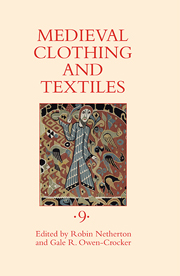Book contents
- Frontmatter
- Contents
- Illustrations
- Tables
- Contributors
- Preface
- 1 Bridal Gifts in Medieval Bari
- 2 The Marriage of the Year (1028)
- 3 Clothing as Currency in Pre-Norman Ireland?
- 4 Cistercian Clothing and Its Production at Beaulieu Abbey, 1269–70
- 5 Clothing and Textile Materials in Medieval Sweden and Norway
- 6 The Iconography of Dagged Clothing and Its Reception by Moralist Writers
- 7 Domestic Painted Cloths in Sixteenth-Century England: Imagery, Placement, and Ownership
- Recent Books of Interest
- Contents of Previous Volumes
5 - Clothing and Textile Materials in Medieval Sweden and Norway
Published online by Cambridge University Press: 05 July 2013
- Frontmatter
- Contents
- Illustrations
- Tables
- Contributors
- Preface
- 1 Bridal Gifts in Medieval Bari
- 2 The Marriage of the Year (1028)
- 3 Clothing as Currency in Pre-Norman Ireland?
- 4 Cistercian Clothing and Its Production at Beaulieu Abbey, 1269–70
- 5 Clothing and Textile Materials in Medieval Sweden and Norway
- 6 The Iconography of Dagged Clothing and Its Reception by Moralist Writers
- 7 Domestic Painted Cloths in Sixteenth-Century England: Imagery, Placement, and Ownership
- Recent Books of Interest
- Contents of Previous Volumes
Summary
This article examines the materials used for clothing in medieval Scandinavia, based on a variety of written sources. Archaeological finds of textiles from Scandinavia have been published to some extent, and there also exist some surveys on clothing in medieval literature. However, little work has been done on the textile information found in Scandinavian documentary sources from the Middle Ages. The production of textiles in Western Europe in the Middle Ages has been the topic of research for a long time, and in recent decades the study of textile consumption has also become more prominent. Yet, Sweden and Norway, along with the other Nordic countries (Denmark, Finland, and Iceland), have largely remained white areas on the map regarding the consumption of textiles. This is despite the fact that most of the preserved clothing from the Middle Ages has been found in the Nordic countries. My doctoral dissertation and this article are the first attempts to study the consumption of textiles and clothing in medieval Sweden and Norway according to the evidence in documentary sources.
The article starts with a short discussion of the various kinds of documents used. Then it continues with the results of my research, starting with textiles and then continuing with furs. After that I consider the development over time and, finally, differences with respect to region, gender, and social status.
- Type
- Chapter
- Information
- Medieval Clothing and Textiles 9 , pp. 97 - 120Publisher: Boydell & BrewerPrint publication year: 2013



